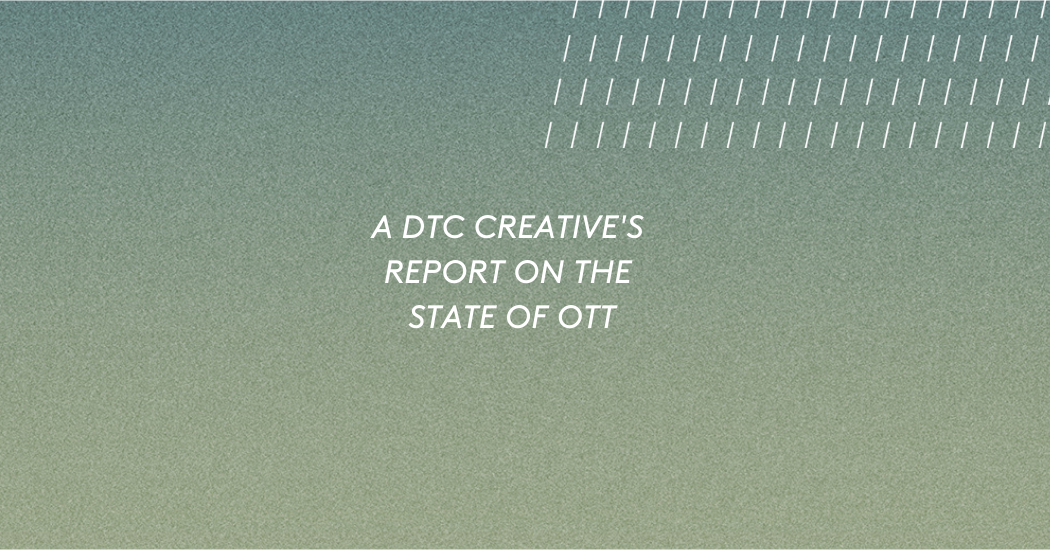A DTC Creative’s Report on the State of OTT

Sometimes, things change so slowly, you hardly notice. And sometimes they change so quickly, your head spins. Welcome to the new world of OTT. If I had to sum up the state of advertising DTC brands on OTT in two words, they would be “total” and “disruption.” In just this past year, decades-old best practices went out the window and have been replaced with quickly-evolving new learnings. And because we’re all ingesting this knowledge at different speeds, it’s difficult to keep everything (creative, media, measurement) and everyone (clients, agency, and platforms) in alignment. I can’t predict where this is going, but I can tell you where we are today. Here are some of the current trends:
1. DTC Brands are going bonkers for OTT. Most of the advertising is for some sort of digitally native vertically integrated brand (DNVB): Athletic Greens, Carvana, CarGurus, Grubhub, DoorDash, SoFi, Chime, Thumbtack, The Zebra, Greenlight, HomeLight, HelloFresh, Grove, etc. The current growth of DTC advertising on OTT is staggering, and eMarketer forecasts ad spend on CTV to be $24.2 billion in 2023.
2. Performance ads are looking more and more like brand ads. And the classic rules of performance TV advertising are softening. Today, you’d be hard-pressed to tell the difference between a “performance” ad and a “brand” ad. Not long ago, there was a clear distinction between “general” advertising and “direct”. It didn’t take any sort of expert to tell one from the other. If it wasn’t clear as day, it certainly was clear as “call today.” But not anymore. Those two worlds have converged.
3. The goal of DTC advertising has shifted. At one time it was clearly about driving sales and the acquisition of customers. CPA was the metric of success. Now the KPIs are softer. Even pure DTC brands are seeking awareness and attention. It’s somewhat paradoxical that companies that are DTC at heart are shifting to evaluate brand metrics.
What’s Driving these Trends?
Well, there are multiple factors. As the amount of DTC brands grows, the marketing work is being done (more and more) by people and agencies with very little DTC experience. And they are bringing “fresh” assumptions to the work. When a brand agency gets a DTC assignment, they apply brand rules to the game. They seek to be different, to stand out, to be memorable, to do something that’s never been done before. From a creative freedom perspective, that is good news. But are they leaving sales on the table? Is this creative as effective as it can be? Well, I guess it depends on your KPIs.
Over the past couple of years, the metrics have changed. Many DTC brands are startups looking toward a liquidity event. They want fame as much as ROI. And some very forward-thinking CMOs have concluded that merely being efficient is not a way to build a brand. Some are putting priority on brand-building, where their predecessors would care only about a low CPA.
How are DTC Brands Shaping their Creative?
There are other factors that are driving the way DTC brands shape their creative. For a long time, the data showed that TV in longer lengths was more efficient. Dollar for dollar, more viewers could be persuaded using 60-second and 120-second spots than with 30-second and 15-second. But in OTT, that sort of inventory isn’t available. And in OTT, TV spots longer than 30-seconds stand out like sore, irritating thumbs; they are not tolerated by the viewers and are therefore shunned by the platforms.
Another aspect is that OTT has allowed many more advertisers to get into the TV game. These advertisers, while new to TV, gained most of their learning from digital advertising. And so, we are seeing digital tactics being used in TV. That’s why a lot of 15-second TV spots look more like banner ads. They are too often looking for that one high-performing asset while overlooking beneficial campaign effects. That’s one of the reasons an OTT viewer will constantly see the same ad over and over.
Prior to this period of disruption, the art of effective advertising had been fairly clear. In performance work, to get a customer to buy, sign up or take some sort of desired action, we needed to do three things very well: create engagement, then persuade, then ask the viewer to take action. And to do good brand advertising, we needed to gain attention and differentiate. In DTC, ideally, we would achieve both simultaneously. But that’s just not happening much.
Can Brands Be Memorable without Being Cheesy?
Over the past few weeks, I have seen countless DTC ads that create engagement but achieve almost no persuasion. Except for a brief flash of a URL at the end, those spots function more like weak brand ads. The creators of these campaigns are either using a search-driving strategy with the goal of closing the sale online, or they assume (naively) that an advertiser only needs to draw attention in order to succeed. Additionally, a lot of DTC advertisers seem oblivious to the fact that their competitors are offering indistinguishable products at similar prices. There are more than a hundred mattress-in-a-box brands, dozens of DTC eyewear companies, a handful of tele-therapy companies, and multiple meds-by-mail services. Watch a few of these back-to-back and then try to tell them apart. It won’t be easy.
I also observed a bucket of executions that seemed completely indulgent. For some reason, lots of advertisers are running DTC ads that simply seek to entertain and do nothing else. “Memorable” was a strategy that worked for brands stacked side by side in the retail aisle. But if you want someone to act, that is not enough. To make matters worse, most of these ads were not actually memorable.
Of course, “traditional” DTC TV is still alive. I saw a significant amount of promo codes and testimonials and prominent lower third graphics. But I didn’t see much of this in use for premium brands, for fast companies, or for disruptive DTC brands. Most of the “traditional” DTC ads were run by cheesy brands for cheesy products. Here and there, I came across cheesy executions that made otherwise premium brands seem cheesy. How did we end up with such extremes?
It was good to see a decent number of spots that did a nice job of engagement, while including at least some effective amount of persuasion. They told me what the product does and gave me a benefit or two. Plus, they left the URL on-screen most of the time to act as a persistent call to action. That work gave me hope.
DTC Brands Need DTC Creative Experts
As DTC brands rise, I believe we will see an increasing amount of mediocre DTC TV, and we will also see a lot more wasteful DTC TV. But since neither of those approaches will generate ROI, I would expect these types of ads to come and go quickly. That said, some creatives out there clearly know how to make effective and even beautiful DTC work. I hope that the new DTC brands seek out those experts.
Where is this all headed? For now, we are roaming the corridors of an advertising Tower of Babel. Everyone is speaking a different language, with little agreement regarding objectives, measurement, and tactics. In a way, it feels like we are back in the early days of the dot com boom. Does anyone remember the sock puppets and cannon-launched gerbils?
I, for one, plan to join hands with my media and analytics colleagues—and hold on tight. If we stay connected, I think we can navigate this as a team. But we’re going to have to be very nimble. This year is going to be a wild ride.
